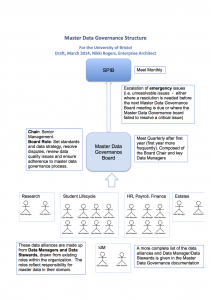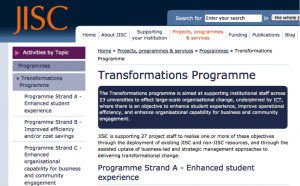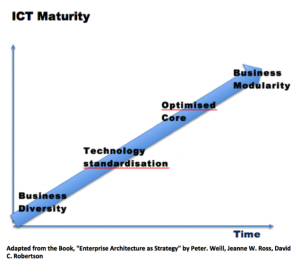As a follow on to my blog post that reflected on year 1 of EA at Bristol (https://enterprisearchitect.blogs.bristol.ac.uk/2012/04/17/looking-back-on-the-first-year-of-my-ea-role-at-bristol/), here’s a summary of the top three key things I covered in year 2:
- Embedding EA within the Governance Structure at Bristol. One problem I wanted to tackle was that of how to ensure that EA is a formal consideration whenever new IT-related projects are proposed at Bristol, whether that should involve in-house IT development or the procurement of third-party systems. Until this second year, EA was being acknowledged as valuable at Bristol, but there was no place in the project approval process at which the Enterprise Architect could make a clear recommendation based on an appraisal of some new project’s fit with Bristol’s business architecture, information architecture, and technical architecture. When I started in my role I was invited to be part of a group called the System Programme Managers Group (SPMG) which met monthly to review current and proposed projects, and which was comprised of managers leading various University programmes (IT, Education, Planning etc). I ran a workshop with this group entitled “Capacity for Change” and I talked about how we should review potential projects in terms of what priority they should have in the already packed project portfolio that the University was funding. This, in combination with some senior level initiatives culminated in the renaming of the SPMG to the “Portfolio Management Group” (PMG). Its new remit is now to support the higher level Portfolio Executive group more directly by making recommendations on any new project’s fit with the strategic priorities of the University. We have aligned the strategic priorities with the benefits mapping work I mention above, and each new business case is now submitted with a PMG recommendation, describing whether we have existing resources to support the proposed project, its priority level, and a statement of its fit with the enterprise architecture – hurray! So, this is not to say that Enterprise Architecture considerations now dictate decision-making, just that it has become formally recognised as part of the project approval governance process; a positive step forward.
- Developing the SOA roadmap for Bristol. After the workshop for the Portfolio Executive, mentioned above, I submitted a Stage 0 business case (entitled Master Data Integration Framework) which was approved. The next step is to develop the Stage 1 business case, for presentation to the Portfolio Executive this Autumn, and for this I am developing the roadmap, with an indication of costs and benefits along the way, in consultation with others. For this work I have maintained a completely separate blog, see: http://coredataintegration.isys.bris.ac.uk/category/final-project-report/ for more information. The initial roadmap I produced for Bristol can be summarised as follows,
Step 1. Make the initial business case for Service Oriented Architecture (SOA) (even if it is not explicitly called ‘SOA’ at this stage) to achieve senior level understanding of the importance of a good data architecture 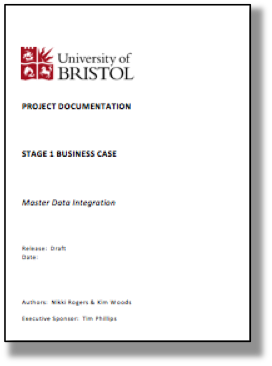 and why investment in this apparently invisible middleware layer will bring benefit to the institution.
and why investment in this apparently invisible middleware layer will bring benefit to the institution.
Step 2. Complete the data dictionary and the interface catalogue to at least 80% for all master data system integrations.


See my separate blog for why this is important: http://coredataintegration.isys.bris.ac.uk/2013/06/16/important-documentation-for-soa-the-interface-catalogue-and-data-dictionary/. The benefits at this point are:
- Faster (cheaper) implementation of new IT systems (quicker to assess impact of a system change on other systems)
- Faster (cheaper), more reliable Business Intelligence/Operational report production
Step 3: Introduce data governance.

By introducing data stewards who will be responsible for ensuring that no master data system changes in data structure ‘go live’ before a check has been done against the interface catalogue and the data dictionary (through a formally defined process), then the benefit we introduce at this point is:
- A more sustainable IT architecture and a higher guarantee that business processes will function without disruption. This is due to data being managed as an institutional asset and ongoing changes to master data structures being managed in a controlled way as they propagate throughout our IT system landscape (avoiding system and process failure and/or damage to our organization’s reputation)
Step 4: Analyse the interface catalogue and develop a logical data model from the data dictionary. Our interface catalogue already reveals the high percentage of point to point interfaces that replicate very similar data synchronisation tasks between IT systems. We can at this point make recommendations regarding how we can reduce this percentage dramatically and refine the integrations into a minimal number of key data services to share master data across the systems that require it. This is where we relate SOA planning to the business architecture of the University, with an appreciation of how data is used across the student and research lifecycles. This step therefore requires business analysis as well as technical systems analysis.
The benefit of doing it is that we are able to describe more specifically the cost-savings and agility that the University stands to gain if it invests in consistently applied SOA technology. We can note that Gartner’s research demonstrated that 92% of the Total Cost of Ownership – http://www.gartner.com/it-glossary/total-cost-of-ownership-tco/ – of an average IT application, based on 15 years of use, is incurred after the implementation project has finished. A significant part of those costs will be concerned with maintaining the application’s seamless integration within the organisation’s application architecture, so by simplifying this we should save costs over time.
Naturally, the other purpose of doing this step is so that we can analyse the “As Is” architecture and design the “To Be” architecture – a precursor for step 5.
Step 5: Adopt a SOA technology solution, train IT developers to use it.
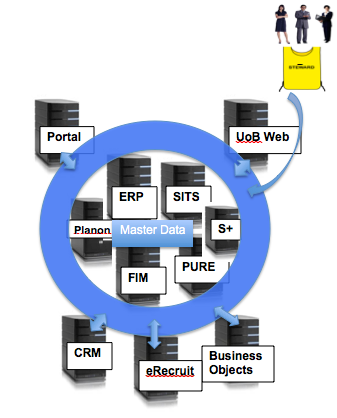
The analysis from Step 4 should have provided us with the basis from which to design the data integration architecture we need. The ‘blue ring’ diagram is not a formal systems architecture diagram by any means, it is simply used to roughly illustrate the concept of a master data systems architecture through which we decouple systems requiring master data from connecting direct to the master data systems themselves (avoiding the proliferation of point to point systems integrations that we suffer from currently). We should have learned through step 4 where we need real-time data, near real-time data and where real-time data is not essential. We can therefore look for the most key processes that we need to support via ESB technology and where, in other places, nightly refreshes of data will ‘do’. We can prioritise which master data services we want to implement in which order, using our favoured SOA technology (whether we go the opensource or commercial route). We can decide if we want to keep and improve our operational datastore and we can determine carefully whether we deliberately want to maintain some point-to-point, database-database integrations (i.e. analyse where in fact, web services, say, will not offer us greater benefit if we acknowledge the trade off between maintaining existent Oracle database to Oracle database connections versus the possible reduction in performance if we deploy data service intermediaries). We need a dedicated team of trained developers to monitor and operate the data integration architecture according to standards we define (SOA governance), to understand how to optimise data caching within it and so on. At this point the benefits we expect to achieve are:
- Cheaper, less complex to maintain, standardized master data integration architecture (blue ring).
- Higher guarantees of data security & compliance (data services to have Service Level Agreements and data security to be built in from the outset)
- Agility to respond quickly to Cloud and Shared Services opportunities
- Quicker to respond to changes in external reporting data structures (KIS, HESA, REF etc.)
Step 6: Train our IT developers and Business Analysts to work together using a standard set of skills and tools based around BPEL, BPM etc.
At this point we expect to reach the level of SOA sophistication where we have the ability to orchestrate and optimize end to end processes that share and manipulate data, creating efficiencies and business agility across the institution.
Suffice it to say, we are some years off Step 6! We are currently working on steps 2-4 above. This Autumn I am running a knowledge exchange workshop for HEI’s working on SOA roadmaps to gather and compare and contrast their plans, successes and lessons learned to date. If you are interested in coming, please contact me directly.
